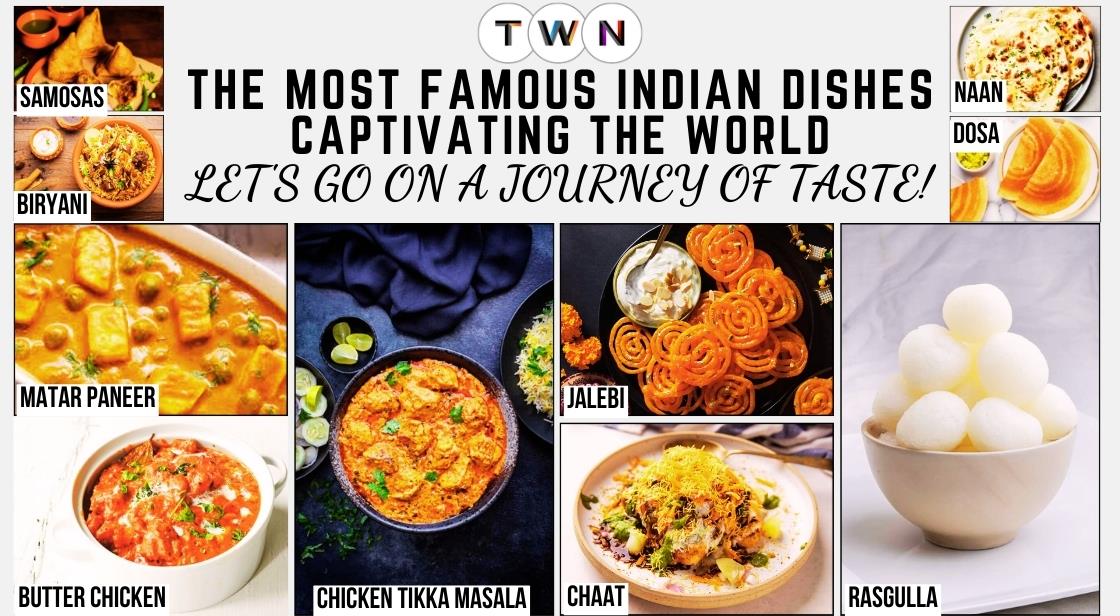The Most Famous Indian Dishes Captivating the World: Let's go on a journey of taste!

Blog Post
Indian cuisine has undergone a remarkable transformation from being a local delight to achieving global recognition as one of the most diverse and flavorful culinary traditions in the world. With its rich tapestry of flavors, aromatic spices, and vibrant colors, Indian dishes have transcended borders, captivating food enthusiasts and earning a well-deserved place on international menus.
From the bustling streets of Mumbai to upscale restaurants in New York City, the allure of Indian cuisine continues to grow, offering a tantalizing journey for the taste buds. As we embark on a culinary adventure to explore the most famous Indian dishes captivating the world, it's evident that these culinary gems represent more than just food – they embody centuries of tradition, cultural diversity, and culinary innovation.
Join us as we delve into the rich history and timeless appeal of iconic Indian dishes like Butter Chicken, Chicken Tikka Masala, Biryani, Samosas, Dosa, Naan, Matar Paneer, Rasgulla, and Jalebi, discovering the fascinating stories, flavor profiles, and global impact of each culinary masterpiece.
From the streets of Delhi to the shores of distant continents, Indian cuisine's journey is a testament to its enduring legacy and universal appeal, inviting food lovers everywhere to savor the magic of its flavors and embrace the spirit of culinary exploration.
As you explore this blog post, you'll gain a deeper appreciation for the vast culinary landscape of India and the reasons why Indian food has captured hearts (and stomachs) around the globe.
The rich tapestry of Indian cuisine reflects the country's cultural diversity and culinary heritage, offering a kaleidoscope of flavors, textures, and aromas that tantalize the senses. As Indian restaurants proliferate in cities across the globe, the popularity of Indian dishes continues to soar, with food lovers seeking out authentic flavors and traditional recipes from the subcontinent.
Let's embark on a gastronomic journey to explore the most famous Indian dishes that have transcended borders and gained widespread acclaim on the international stage.
The Most Famous Indian Dishes around the world: A Culinary Journey
Butter Chicken: A Global Craving with a Rich Indian Heritage
Butter chicken, or Murgh Makhani, has transcended its origins in Delhi's kitchens to become a global culinary icon. This dish's popularity is no accident – it's a symphony of textures and flavors that caters to a wide range of palates.
A Journey from Humble Beginnings to International Stardom:
While the exact origin story remains debated, some culinary historians believe butter chicken emerged in the 1930s from leftover tandoori chicken. Resourceful chefs are said to have revived the succulent chicken by simmering it in a creamy tomato gravy enriched with butter and cream. This ingenious creation quickly gained popularity, evolving into the beloved Murgh Makhani we know today.
Beyond the Basics: Unveiling the Secrets of Flavor
The magic of butter chicken lies in its seemingly simple yet incredibly flavorful components:
-
Succulent Chicken: Traditionally, marinated chicken pieces are cooked in a tandoor oven, imbuing them with a smoky depth of flavor. Modern variations might involve pan-frying or grilling the chicken.
-
Velvety Tomato Gravy: The heart of the dish lies in the rich tomato gravy. Ripe tomatoes are simmered with onions, ginger, garlic, and a blend of aromatic spices like garam masala. This base is then blended to a smooth consistency, creating a velvety texture that coats the chicken beautifully.
-
Creamy Indulgence: Butter and cream are added to the gravy, providing a touch of richness and balancing the tanginess of the tomatoes. The specific type of cream can vary depending on the region – heavy cream, cashew paste, or even yogurt can be used to achieve the desired creaminess.
-
Aromatic Spice Symphony: Garam masala, a warm and aromatic spice blend, is the heart and soul of the flavor profile. Other spices like cumin, coriander, turmeric, and fenugreek might also be included, adding complexity and depth to the gravy.
-
A Touch of Sweetness: A hint of sweetness, often from sugar or honey, cuts through the richness and adds another layer of flavor dimension.
Modern Twists on a Classic:
While the core recipe remains relatively unchanged, modern chefs are constantly innovating with butter chicken. Here are some exciting trends:
-
Fusion Flavors: Chefs are experimenting with global influences, incorporating ingredients like coconut milk or Thai curry paste for a unique twist.
-
Healthier Options: Lighter versions might use leaner cuts of chicken, low-fat yogurt, or even cauliflower rice instead of traditional white rice.
-
Vegan Adaptations: Plant-based versions are emerging, featuring ingredients like tofu, tempeh, or jackfruit to replicate the texture and flavor of chicken.
Butter Chicken's Enduring Legacy:
Butter chicken's global appeal lies in its ability to satisfy diverse palates. It's a crowd-pleaser, perfect for both casual and celebratory occasions. The rich and creamy gravy, coupled with the succulent chicken, offers a comforting and satisfying eating experience. Whether you enjoy it with fluffy naan, fragrant basmati rice, or a cooling raita, butter chicken is a culinary journey that will leave you wanting more.
So, the next time you encounter this global favorite, take a moment to appreciate its rich heritage and the innovative spirit that keeps it relevant in today's ever-evolving culinary landscape.
2. Chicken Tikka Masala: A Fusion Feast with Global Recognition
Chicken tikka masala, a dish as intriguing as its name, has transcended its origins to become a global phenomenon. While its exact birthplace remains a source of friendly debate, one thing is certain: this creamy tomato-based curry, featuring succulent marinated chicken, has become a cornerstone of British Indian cuisine, capturing hearts (and stomachs) worldwide.
A Culinary Fusion Story:
The exact origin story of chicken tikka masala is shrouded in delightful mystery. Some theories suggest it emerged from the kitchens of South Asian immigrants in Britain during the mid-20th century. These resourceful chefs might have adapted flavors and ingredients familiar to them, creating a dish that resonated with the local palate.
Chicken tikka masala is believed to be a fusion of two popular dishes: chicken tikka, marinated and grilled chicken pieces, and creamy tomato-based curries from the Indian subcontinent. This innovative blend of flavors and textures became a runaway success, establishing itself as a staple in British Indian restaurants.
Unveiling the Layers of Flavor:
Chicken tikka masala's global appeal lies in its seemingly simple yet incredibly flavorful components:
-
Marinated Chicken: Chicken pieces are marinated in yogurt, usually flavored with ginger, garlic, lemon juice, and a blend of spices like garam masala and tandoori masala. This process tenderizes the chicken and infuses it with aromatic flavors.
-
Tandoor Magic: Traditionally, the marinated chicken is cooked in a tandoor oven, imparting a smoky depth of flavor and a slightly charred exterior. Modern variations might involve pan-frying or grilling the chicken.
-
Luscious Tomato Gravy: Ripe tomatoes are simmered with onions, ginger, garlic, and a blend of spices like cumin, coriander, and turmeric. This base is then blended to a smooth consistency, creating a rich and flavorful sauce for the chicken.
-
Creamy Indulgence: Cream or butter is added to the gravy, providing a touch of richness and balancing the tanginess of the tomatoes. The type of cream can vary – heavy cream, coconut milk, or even cashew paste can be used to achieve the desired texture and depth.
-
Aromatic Spice Symphony: Spices play a crucial role in the flavor profile. Garam masala, a warm and aromatic blend, is often used along with individual spices like cumin, coriander, turmeric, and paprika. These spices add complexity and depth to the gravy.
-
A Hint of Sweetness: A touch of sugar or honey is often included to cut through the richness and add another layer of flavor dimension.
Modern Interpretations of a Classic:
While the core recipe remains a crowd-pleaser, modern chefs are constantly innovating with chicken tikka masala:
-
Fusion Flavors: Chefs are experimenting with global influences, incorporating ingredients like coconut milk or Thai curry paste for a unique twist.
-
Healthier Options: Lighter versions might use leaner cuts of chicken, low-fat yogurt, or even cauliflower rice instead of traditional white rice.
-
Vegan Adaptations: Plant-based versions are emerging, featuring ingredients like tofu, tempeh, or jackfruit to replicate the texture and flavor of chicken.
Chicken Tikka Masala's Enduring Legacy:
Chicken tikka masala's global success lies in its ability to cater to diverse palates. It's a dish that bridges cultures, offering a unique blend of Indian spices and creamy textures. Whether you enjoy it with fluffy naan, fragrant basmati rice, or a cooling raita, chicken tikka masala is a culinary journey that continues to tantalize taste buds worldwide. So, the next time you savor this delightful dish, take a moment to appreciate its intriguing origins and the innovative spirit that keeps it relevant in today's ever-evolving culinary landscape.
Also Read: Discover the World's Most Romantic Honeymoon Destinations
3. Biryani: A Journey Through Layers of Flavor and History
Biryani, a name synonymous with aromatic rice and captivating flavors, has transcended its royal origins in India to become a global culinary treasure. This layered dish, featuring fluffy basmati rice interlaced with succulent meat or vegetables, aromatic spices, and garnishes like nuts and fried onions, is a celebration of textures and tastes. Biryani's journey extends far beyond Indian borders, with regional variations captivating palates across the Middle East, Southeast Asia, and beyond.
A Legacy Steeped in Royalty:
The exact origin story of biryani remains shrouded in some mystery, but historical evidence suggests its roots trace back to the royal kitchens of Mughal India. Mughal emperors, known for their love of elaborate feasts, are believed to have played a significant role in developing this iconic dish. Biryani's preparation involved layering meats like lamb or chicken with fragrant rice, spices, and nuts, creating a visually stunning and flavorful culinary masterpiece.
A Symphony of Flavors and Textures:
The magic of biryani lies in its ability to combine a multitude of elements into a harmonious whole. Here's a glimpse into the key components:
-
Fragrant Basmati Rice: The foundation of biryani is long-grain basmati rice, known for its delicate aroma and fluffy texture. The rice is often cooked with saffron, cardamom, and other spices, adding depth of flavor.
-
Succulent Meat or Vegetables: Traditionally, biryani features meat like lamb, chicken, or goat. However, vegetarian versions incorporate vegetables like potatoes, peas, and cauliflower, offering a delightful meat-free option.
-
Aromatic Spice Symphony: The heart and soul of biryani's flavor profile lies in the meticulous blend of spices. Garam masala, a warm and aromatic blend, is often used alongside individual spices like cloves, cardamom, cumin, coriander, and turmeric. These spices are used whole or ground, adding complexity and depth to the dish.
-
Rich and Flavorful Gravy: Some biryani variations incorporate a flavorful gravy made with yogurt, onions, tomatoes, and spices. This gravy adds moisture and richness to the rice and meat.
-
Delightful Garnishes: The final touch comes in the form of garnishes like fried onions (giving a delightful textural contrast), fresh coriander leaves, and nuts like almonds or cashews, adding visual appeal and textural intrigue.
Biryani's Global Appeal: A Fusion Feast
Biryani's journey extends far beyond the borders of India. As trade routes flourished, biryani found its way to various regions, each adopting and adapting the dish to local ingredients and preferences. Here's a glimpse into the global tapestry of biryani:
Pakistani Biryani:
Pakistani biryanis are known for their use of Sindhi biryani rice, a short-grain variety with a distinct nutty flavor. They often feature stronger notes of cardamom and kewra water (a fragrant floral water).
Afghan Kabuli Pulao:
This Afghan variation features long-grain rice flavored with raisins, carrots, and almonds. It's known for its vibrant orange color and slightly sweet flavor profile.
Memoni Biryani:
This Sindhi Muslim version incorporates a unique spice blend called "saalan" and often features diced beef or mutton.
Modern Twists on a Classic:
While traditional recipes remain cherished, modern chefs are constantly innovating with biryani:
-
Fusion Flavors: Chefs are experimenting with global influences, incorporating ingredients like coconut milk or even fragrant Thai curry pastes for a unique twist.
-
Healthier Options: Lighter versions might use leaner cuts of meat, brown basmati rice, or even cauliflower rice for a more health-conscious approach.
-
Vegetarian Delights: Vegetarian biryanis are becoming increasingly popular, featuring a delightful array of vegetables cooked to perfection.
Biryani's Enduring Allure:
Biryani's enduring popularity lies in its ability to offer a complete and satisfying meal in itself. It's a dish that caters to diverse palates, offering a delightful interplay of textures and flavors. Whether enjoyed during celebratory occasions or as a comforting weeknight meal, biryani continues to tantalize taste buds and hearts around the world.
So, the next time you encounter this fragrant and flavorful dish, take a moment to appreciate its rich history, the artistry involved in its preparation, and the diverse culinary journey it represents.
4. Samosas: A Global Bite of Indian Street Food Magic
Samosas transcend their humble beginnings as Indian street food to become global ambassadors of flavor. These golden-fried parcels, with their contrasting crisp exterior and savory filling, are a delightful explosion of textures and tastes.
A Legacy of Flavorful Innovation:
The exact origin of samosas remains debatable, with some culinary historians tracing their roots back to ancient Persia. Over time, samosas migrated to India, where they evolved into the beloved street food we know today. Traditionally, the pastry shell was made with wheat flour, but regional variations might incorporate chickpea flour or even flaky puff pastry for a unique twist.
A Symphony of Textures and Fillings:
The beauty of samosas lies in their delightful combination of textures and flavors:
-
Crispy Shell: The exterior is typically made with unleavened dough, rolled out thin and deep-fried until golden brown. This process creates a satisfyingly crisp and slightly flaky shell that contrasts beautifully with the soft filling.
-
Savory Filling: The most popular filling features a spiced potato and pea mixture, seasoned with aromatic spices like cumin, coriander, turmeric, and chili powder. Variations might include lentils, minced meat (like lamb or chicken), or even cheese for a vegetarian delight.
-
Aromatic Accoutrements: Samosas are often served with chutneys, offering a delightful burst of flavor and a cooling contrast to the warmth of the spices. Popular accompaniments include mint chutney, tamarind chutney, or even a yogurt-based raita.
Beyond Borders: A Global Street Food Sensation
Samosas have transcended their Indian origins to become a beloved street food across the globe. Here's a glimpse into their international journey:
Pakistani Samosas:
Pakistani samosas often feature a thicker pastry shell and a spicier filling, sometimes incorporating minced beef or mutton.
Tibetan Samosas:
In Tibet, samosas are known as "samosa cha" and are typically filled with vegetables and served with a spicy tomato sauce.
East African Samosas:
East African variations, like the Kenyan samosa, might incorporate ingredients like lentils or coconut into the filling.
Modern Twists on a Classic:
While the core concept of samosas remains a crowd-pleaser, modern chefs are constantly innovating:
Fusion Fillings: Chefs are experimenting with global flavors, incorporating ingredients like shredded barbecue chicken or even a Mexican-inspired vegetarian filling with black beans and corn.
Mini Samosas: Bite-sized samosas are becoming popular for appetizers or party snacks.
Baked Samosas: For a healthier option, some variations involve baking the samosas instead of deep-frying them.
Samosas' Enduring Allure:
Samosas' enduring popularity lies in their affordability, portability, and ability to satisfy diverse palates. They are the perfect street food snack, offering a delightful combination of textures and flavors in every bite.
Whether enjoyed at a bustling Indian bazaar or recreated in your own kitchen, samosas offer a delicious glimpse into Indian street food culture and its global influence. So, the next time you encounter these crispy parcels, take a moment to appreciate their rich heritage, the creativity of their fillings, and the global journey they represent.
5. Dosa: A South Indian Crepe that Conquered the World
Dosa, a thin and crispy crepe hailing from South India, has become a global ambassador for South Indian cuisine. This fermented wonder, made from a batter of rice and lentils, boasts a delightful interplay of textures and flavors. The dosa's slightly sour tang and satisfying crispness create a delightful base for a variety of fillings and accompaniments, making it a beloved breakfast, snack, or even light meal.
A Tradition Steeped in Fermentation:
The magic of dosa lies in its fermented batter. Rice and lentils, typically urad dal (black gram), are soaked and ground together. This fermentation process not only breaks down complex carbohydrates, making the dosa easier to digest, but also adds a depth of flavor and a characteristic slight tang. This batter is then spread thin on a hot griddle and cooked until crisp, creating a versatile canvas for culinary creativity.
A Symphony of Flavors and Textures:
The beauty of dosa lies in its versatility. Here's a glimpse into the key components:
-
Crispy Crepe: The star of the show is the dosa itself. The fermented batter creates a thin, crispy crepe with a slightly fermented flavor.
-
Flavorful Fillings: Dosa can be enjoyed plain (plain dosa) or stuffed with a variety of fillings. Masala dosa, the most popular variation, features a spiced potato filling, while paneer dosa boasts a savory stuffing of Indian cottage cheese. Onions, vegetables, or even shredded chicken can also be incorporated for a protein boost.
-
Accompaniments: Dosa is traditionally served with sambar, a lentil stew bursting with flavor and vegetables. Coconut chutney, with its refreshing coolness and hint of sweetness, provides a delightful counterpoint to the savory dosa and sambar.
Dosa's Global Appeal: Beyond Borders
Dosa's popularity extends far beyond the borders of South India. Here's a glimpse into its international journey:
-
Sri Lankan Dosa: Sri Lankan dosa variations might incorporate grated coconut or even semolina into the batter for a unique twist.
-
Singaporean Dosai: In Singapore, dosa is often served with a spicy peanut chutney alongside the traditional sambar and coconut chutney.
-
Fusion Dosas: The global influence is evident in fusion dosa creations, featuring fillings like cheese dosa or even a Mexican-inspired dosa with a tomato salsa filling.
Modern Twists on a Classic:
While the core concept of dosa remains a crowd-pleaser, modern chefs are constantly innovating:
-
Instant Dosa Batter: For those short on time, pre-made or instant dosa batter mixes are becoming increasingly popular.
-
Healthy Variations: Millets like foxtail millet or kodo millet can be incorporated into the batter for a healthier and gluten-free option.
-
Mini Dosas: Bite-sized mini dosas are gaining popularity for appetizers or party snacks.
Dosa's Enduring Allure:
Dosa's enduring popularity lies in its versatility, affordability, and ability to cater to diverse dietary needs. It's a nourishing and delicious option, offering a delightful combination of textures and flavors in every bite. Whether enjoyed in the bustling streets of South India or recreated in your own kitchen, dosa offers a delicious and healthy glimpse into a vibrant culinary tradition. So, the next time you encounter this crispy crepe, take a moment to appreciate its rich heritage, the creativity of its fillings, and the global journey it represents.
Also Read: Top Hottest Models In The World 2023
6. Chaat
Chaat is a versatile term encompassing a myriad of Indian snacks and street foods, renowned for their bold flavors and tantalizing textures. This culinary category boasts an array of dishes, each offering a unique blend of ingredients and spices to create a symphony of taste sensations. From bustling street vendors to upscale restaurants, chaat holds a special place in Indian cuisine, cherished by food enthusiasts across the globe.
Chaat's essence lies in its ability to combine humble ingredients like chickpeas, vegetables, and spices into mouthwatering creations that tantalize the taste buds. This delightful concoction can be enjoyed as a quick snack on the go or as part of a leisurely meal, adding a burst of flavor to any culinary experience.
Among the plethora of chaat dishes, some stand out as perennial favorites among food lovers:
Pani Puri:
Also known as golgappa or puchka, pani puri is a beloved street food delicacy cherished for its crispy hollow shells filled with a tangy and spicy concoction of flavored water, mashed potatoes, chickpeas, and chutneys. Each bite offers a burst of flavors and textures, making it a must-try for chaat enthusiasts.
Dahi Vada:
Dahi vada, or dahi bhalla, features soft lentil dumplings soaked in creamy yogurt and topped with an array of tangy chutneys, spices, and crunchy toppings like sev and pomegranate seeds. This indulgent dish strikes the perfect balance between creamy, tangy, and spicy flavors, making it a popular choice for appetizers or snacks.
Bhel Puri:
Bhel puri is a delightful mixture of puffed rice, vegetables, chutneys, and spices, tossed together to create a harmonious medley of flavors and textures. This light and refreshing snack is perfect for those craving a savory treat with a hint of sweetness and tanginess, making it a hit among chaat enthusiasts.
While these are just a few examples of the vast array of chaat dishes available, they exemplify the creativity and ingenuity of Indian cuisine. With its rich history and diverse culinary traditions, India continues to inspire and delight food lovers around the world.
Whether you're exploring the bustling streets of Mumbai or dining at a local Indian restaurant, be sure to indulge in the vibrant flavors of chaat for a truly unforgettable culinary experience.
7. Rasgulla
Rasgulla, a beloved Indian sweet, holds a special place in the hearts of dessert enthusiasts, particularly among the people of West Bengal. This delectable treat, characterized by its soft and spongy texture soaked in sugary syrup, is hailed as a culinary gem of the region. However, the origins of rasgulla are shrouded in controversy, with both Odisha and Bengal laying claim to its invention. Despite this dispute, one cannot deny the irresistible appeal of this iconic dessert.
Renowned for its melt-in-your-mouth goodness, rasgulla remains a cherished delicacy in Indian cuisine, earning accolades for its delightful taste and indulgent texture. Whether enjoyed as a festive treat or a simple indulgence, rasgulla continues to captivate the palates of dessert connoisseurs across the country.
While the debate over its origins persists, the essence of rasgulla lies in its ability to evoke feelings of joy and satisfaction with every bite. Whether savored during festive celebrations or as a sweet ending to a meal, rasgulla's enduring popularity is a testament to its timeless appeal and culinary excellence.
8. Jalebi: A Sweet Journey Through Time
Jalebi, a beloved sweetmeat in India, transcends mere regional popularity. This spiral-shaped fried dough, dipped in a fragrant sugar syrup, has captivated taste buds for centuries, weaving its way into the culinary tapestry of the Middle East and beyond.
A Legacy of Sweetness: From Ancient Texts to Modern Cravings
Jalebi's origins can be traced back to ancient Indian cookbooks, with mentions appearing in texts as early as the 15th century. These early recipes hint at a long history of perfecting this delightful treat. Jalebi's journey isn't confined to India. Variations of this sweet delight can be found in countries like Iran (zolbia) and Turkey (zelzele), showcasing its global appeal.
The Allure of Jalebi: Beyond Borders
The magic of jalebi lies in its contrasting textures and flavors. The deep-fried batter boasts a satisfying crisp on the exterior, while the interior remains soft and slightly chewy. This textural play is beautifully complemented by the sugary syrup, infused with fragrant cardamom or rosewater in some regions. Jalebi's vibrant orange hue, often attributed to the use of food coloring like saffron or turmeric, adds a delightful visual element to the experience.
Jalebi's Versatility: A Treat for Every Occasion
Jalebi's popularity extends beyond its intrinsic deliciousness. It's a versatile sweet, enjoyed as a celebratory treat during festivals like Diwali or Eid, or simply as a satisfying afternoon snack. Jalebi can also be paired with savory dishes like Dahi Bhalla (fried lentil fritters dipped in yogurt) for a delightful combination of sweet and savory flavors.
Jalebi's Enduring Appeal
Jalebi's enduring appeal lies in its simplicity and ability to evoke a sense of nostalgia. The sweet aroma and vibrant color instantly transport many to childhood memories, making it a cherished part of cultural traditions. Furthermore, jalebi's relatively inexpensive ingredients make it an accessible treat enjoyed by people from all walks of life.
Jalebi: A Global Sweet Sensation
Jalebi's journey from ancient recipes to modern kitchens across the globe is a testament to its enduring appeal. This sweet treat continues to capture hearts (and satisfy sweet tooths) worldwide, offering a glimpse into the rich culinary heritage of India and beyond. So, next time you encounter this vibrant sweet, take a moment to appreciate its historical significance and the delightful taste experience it offers.
9. Naan: The Versatile Flatbread Complementing Indian Cuisine
Naan, a leavened flatbread boasting a delightful texture and rich flavor, is an integral part of Indian cuisine. It's more than just a side dish; it elevates the entire dining experience.
A Match Made in Heaven: Flavor and Texture
The magic of naan lies in its perfect balance of textures and subtle flavors. Unlike a plain roti, naan is typically prepared in a tandoor oven, infusing it with a smoky aroma and a slightly charred exterior. This char gives way to a soft, chewy interior that's both satisfying and complements curries and other Indian dishes beautifully. Additionally, naan is often brushed with butter or ghee, adding a touch of richness that harmonizes with the spices in Indian food.
A Variety of Naan Options
Naan goes beyond being a simple flatbread. It comes in a variety of options to cater to different taste preferences:
Classic Butter Naan:
This is the most popular variety, offering a comforting combination of the soft naan dough and creamy butter.
Garlic Naan:
For those who love a garlicky kick, this version features minced garlic infused into the dough or brushed on top before baking.
Paneer Naan:
This vegetarian delight incorporates paneer (Indian cottage cheese) into the dough, offering a delightful savory twist.
Keema Naan:
A meat-lover's dream, keema naan features a flavorful minced lamb or goat filling cooked within the naan.
Chili Naan:
For those who crave a fiery touch, chili naan incorporates chilies into the dough, adding a spicy element to the bread.
More Than Just a Side: The Multifaceted Role of Naan
Naan serves a dual purpose at the Indian dining table. First, it acts as a delicious accompaniment to soak up flavorful curries, dals (lentil stews), and chutneys. The soft and slightly chewy texture makes it perfect for scooping up food, eliminating the need for utensils in traditional Indian meals. Second, naan itself can be a flavorful appetizer, enjoyed plain or brushed with various toppings.
The Enduring Allure of Naan
Naan's popularity transcends its taste and versatility. It represents a cultural experience, a way to connect with Indian cuisine on a deeper level. The act of tearing off a piece of warm naan and using it to scoop up flavorful curries is a sensory experience that embodies the spirit of Indian communal dining.
So, the next time you encounter naan, don't underestimate its significance. It's more than just bread; it's a delicious and cultural cornerstone of the Indian culinary experience.
10. Matar Paneer: A Classic Vegetarian Delight from North India
Matar paneer, a vibrant vegetarian dish hailing from North India, is a beloved staple across the country. This flavorful curry combines fresh green peas with melt-in-your-mouth paneer (Indian cottage cheese) in a rich and comforting tomato-based gravy.
A symphony of Textures and Flavors:
The beauty of matar paneer lies in its contrasting textures and harmonious flavors. Soft cubes of paneer, cooked to pillowy perfection, provide a delightful textural contrast to the plump green peas. The tomato gravy, simmered with aromatic spices like garam masala, offers a vibrant tanginess that perfectly complements the creamy paneer and sweetness of the peas. This symphony of textures and flavors makes matar paneer a crowd-pleaser, satisfying both vegetarians and meat-eaters alike.
Beyond the Basics: Variations on a Classic
While the core ingredients of paneer, peas, and tomato gravy remain constant, matar paneer boasts regional variations. Some recipes include chopped onions or bell peppers for added flavor and texture. For a touch of richness, cashews or cream can be incorporated into the gravy. The level of spice can also be adjusted to suit individual preferences.
The Perfect Accompaniment: Embracing Culinary Diversity
Matar paneer is traditionally served alongside a variety of accompaniments, allowing diners to create their own perfect flavor and texture combinations. Here are some popular pairings:
-
Breads: Naan, roti, paratha, or poori all provide delicious options for scooping up the flavorful gravy and enjoying the soft paneer and peas.
-
Rice: Steamed basmati rice offers a neutral base that beautifully complements the rich flavors of the curry.
-
Raita: A cooling yogurt-based condiment with chopped vegetables like cucumber or onions can help temper the heat and add a refreshing touch.
-
Cream: A dollop of cream on top adds a touch of richness and creaminess, further enhancing the overall flavor profile.
Matar Paneer: A Timeless Culinary Treasure
Matar paneer's enduring popularity is a testament to its versatility and ability to satisfy diverse palates. This vegetarian dish offers a delicious and wholesome meal option, perfect for casual weeknight dinners or celebratory occasions. So, next time you're craving a taste of North Indian cuisine, consider indulging in the comforting flavors and delightful textures of matar paneer.
Conclusion:
From the aromatic spices of butter chicken to the fragrant allure of biryani, Indian cuisine has permeated global culinary landscapes, enchanting diners with its diverse flavors and vibrant creations. As the popularity of Indian dishes continues to soar worldwide, it serves as a testament to the enduring legacy of Indian culinary traditions and the universal appeal of its gastronomic treasures. Whether enjoyed in bustling Indian eateries or savored in far-flung corners of the globe, the allure of Indian food remains unrivaled, fostering a deep appreciation for its rich heritage and culinary artistry.
You May Like
EDITOR’S CHOICE












